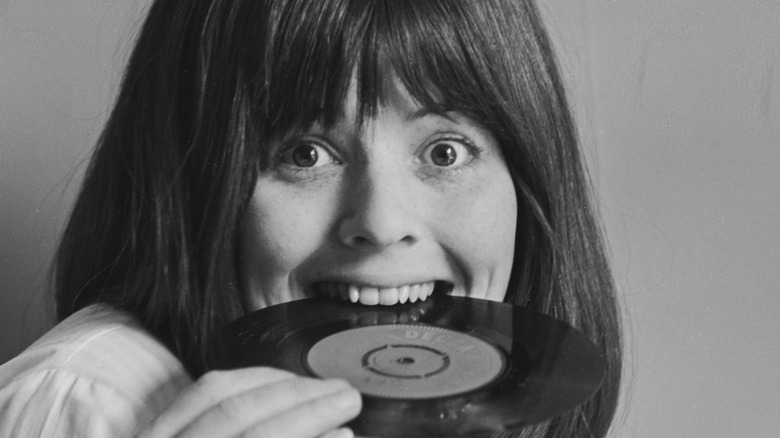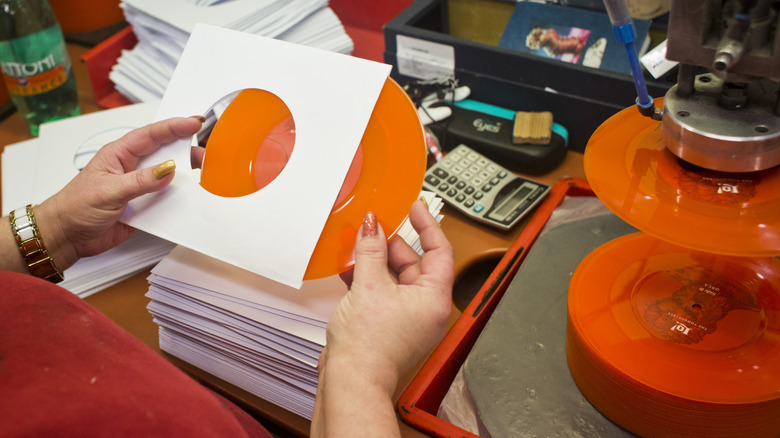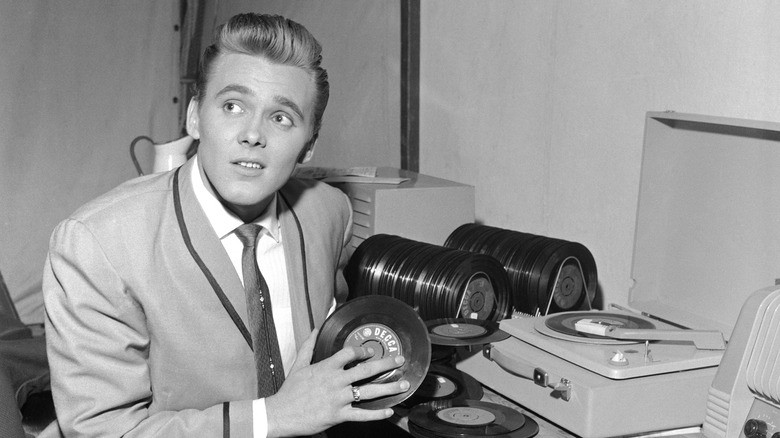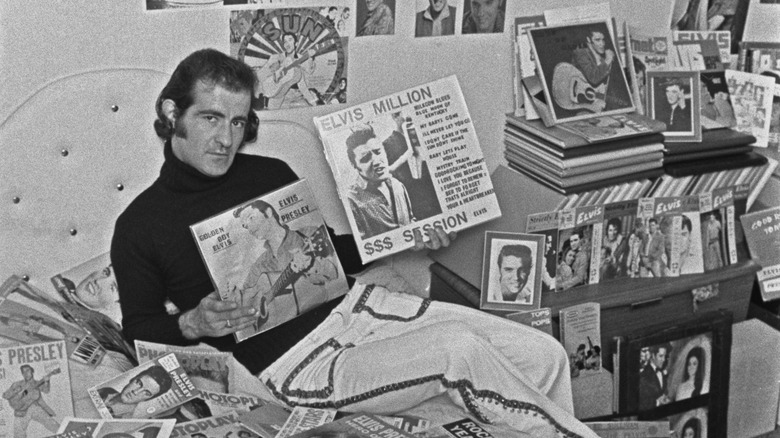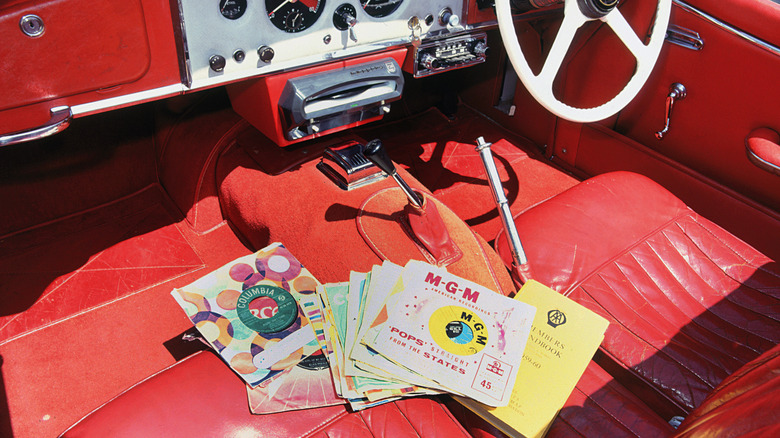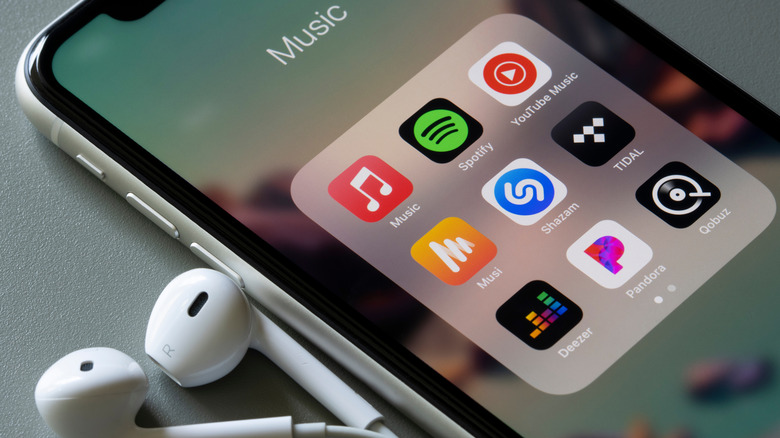The Origin Of The 7-Inch Record
The 7-inch record was an invention of the 1940s that didn't truly blossom until rock 'n' roll exploded almost a decade later. Pop and rock music would transform the humble 7-inch into a vessel for chart-topping singles (via Rolling Stone), and today, the format lives on as low-priced digital downloads and instantly-available streams. Even after being eclipsed by 8-tracks, cassettes, and CDs, the original vinyl itself has made a comeback with collectors.
The 7-inch single — or 45, as it's sometimes known — was such an important part of pop culture that many of the most famous musical acts of the 20th century would have been nothing without it. Many artists pressed their best work not on full-length albums but onto these little singles. Stacks of 7-inch records filled jukeboxes, teens flocked to stores to buy the latest dual-sided singles, and even cars could play 45s at one point. But the story of how this short and sweet format took the world by storm isn't so simple.
At first, shorter records confused customers
The 7-inch record was first introduced in March 1949 by RCA Victor (via Rolling Stone). This smaller format was more than just compact in shape compared to 10- and 12-inch records — it also had a shorter running time than the standard 78 rpm discs of the time. The new 45 rpm single (as in "revolutions per minute," the speed a turntable spins) held just a few minutes of audio on each side. On average, it could play two songs: one on the "A" side and another on the "B."
As Rolling Stone puts it, customers weren't wowed at first; they were confused. Getting up to flip or change a record was already a reality of vinyl listening, so what's the point of doing that even more often? On top of that, RCA's 45 rpm speed wasn't supported by every turntable, and the spindle size was larger. This left sellers frustrated, as they lost potential customers who were unsure if they needed to upgrade their home systems to listen to these new records.
The first 7-inch records
According to Rolling Stone, the first 45s produced by RCA Victor came in a wide range of both musical styles and colors. "That's All Right" by Arthur "Big Boy" Crudup (later a breakout hit for Elvis Presley) sat alongside the Yiddish song "A Klein Melamedl (The Little Teacher)" in the initial roster of 7-inch singles.
As some sources tell it, the 7-inch was the latest salvo in a corporate war between RCA and its rival Columbia — in particular, a response to Columbia's invention of the 33 ⅓ rpm long-playing (LP) vinyl a year earlier. But Inventor's Digest deems this story a myth. RCA had developed the 7-inch in secret a decade earlier, shelving it through World War II. In the meantime, Columbia had developed a successor to the 78 in the 33 ⅓ vinyl, and their chief engineer invited the RCA president and his staff of engineers to get a sneak preview. While the president was cordial, privately, he was furious. He ordered his team at RCA to resurrect the 7-inch single and launch it in 1949 to undercut their competitor.
Singles made rock 'n' roll
At the end of 1949, RCA was cranking out 7-inch records at more than 25 million units a year, and by 1955, Bill Haley and the Comets' single "Rock Around the Clock" would move 3 million records (per Inventor's Digest). Teenagers were smitten with the smaller format (often priced at under a dollar each), and throughout the '50s and '60s, non-album singles would revolutionize the landscape of popular music, with some of the biggest hits of the era launching in the new format. From "Penny Lane" and "Strawberry Fields Forever" to "Blitzkrieg Bop" and "Rapper's Delight," the 7-inch single proved to be as influential to pop and rock music as the amplifier and microphone and peaked in 1974 with annual sales at 200 million units.
Rolling Stone called it the "iTunes 99-cent download or surprise single ... of its day." The 7-inch single had so much cultural power that many artists — from Nirvana to The White Stripes — released their first work on 45s even when cassette tapes and CDs were en vogue. And the beauty of a single was in its self-contained, singular nature. Singles often featured unique artwork on their album covers — catnip for collectors — and a bonus song, outtake, or extended version of the main track on its "B" side.
Drivers could cruise to the tunes of 7-inch records
Music and road trips go together like peanut butter and jelly. But drivers in the 1950s really only had one option to crank the tunes: the radio. Radios, naturally, are a bit finicky with their signal strengths and DJs, but that all changed when automobile manufacturers began offering 7-inch record players in their vehicles.
Consumer Reports details the beginning of driver-curated audio in the 1950s and '60s with the introduction of devices like Chrysler's Highway Hi-Fi. Chrysler's option was available on four of their 1956 automobiles via technology developed by CBS Labs that played specially designed Columbia records on 7-inch discs at 16 ⅔ rpm. These ranged from Great American Songbook standards to CBS News and history specials. It wasn't exactly a hit, with the need for proprietary discs hampering its popularity. RCA was quick to swoop in with their Victrola, which could play a driver's personal collection of 45s — a much more convenient option.
But while these players helped drivers keep custom playlists decades before mixtapes and iPods, the high pressure needed by the machine to keep the needle steady meant more wear and tear on the vinyl. It was definitely a tradeoff.
The spirit of the 7-inch single lives on
The popularity of 7-inch singles has certainly waned — especially in the "album-rock" era of the 1970s to 2000s, during which LP records took over as many bands' primary artistic vehicle. But the single experienced a renaissance as digital downloads and streaming came into prominence. The very first downloadable single from a major artist was Duran Duran's "Electric Barbarella," released online in 1997 by Capitol Records (via Billboard), four years before Apple's iTunes would popularize digital sales of individual songs.
The modern pop music landscape seems to have come full circle since then, with newer artists like Lil Nas X and Cardi B establishing themselves with multiples singles before ever releasing an album. Rolling Stone wrote that contemporary artists are defying the longstanding method of releasing a single leading up to an album and a single after release; instead, artists like Camila Cabello launch six singles in advance of an LP, and established artists like Taylor Swift and Justin Timberlake have followed suit.
In speaking with the heads of marketing at major labels, Rolling Stone found that this new strategy was a reaction to a fast-moving world powered by platforms like Spotify and Instagram. "Traditionally, artists would go a long time between album projects, disappear and then come back as a big event," Robbie Snow, the SVP of Global Marketing for Hollywood Records, told the publication. "In this day and age, we try to keep things flowing, so artists almost never go away."
